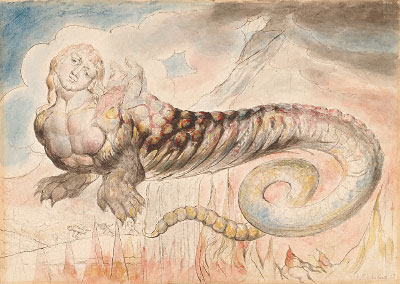Osip Mandelstam on Dante's Imagery
Yesterday's post quoted the Russian poet Osip Mandelstam talking about Niko Pirosmanashvili, a visual artist. As background for tomorrow's post, I'd like to cite something Mandelstam had to say about a fellow literary artist. The quote below comes from Mandelstam's "Conversation About Dante," a lengthy essay about the work and technique of a poet whom Mandelstam revered.Mandelstam uses Canto XVII of Dante's Inferno to illustrate his most fundamental idea about how imagery is used creatively. Canto XVII tells of Dante's descent from the seventh circle of Hell to the eighth, known as Malebolge. Because there is no route for going on foot, he and his guide Vergil ride on the back of Geryon, whom Dante describes as a winged beast with the tail of a scorpion but the face of an honest man (see the image by William Blake below).

Source: National Gallery of Victoria (Australia)
Mandelstam's description of how a master poet like Dante uses imagery:
"Now let's try to grasp all of Canto XVII as a whole, but from the point of view of the organic chemistry of Dantean imagery, which has nothing in common with allegory. Instead of merely retelling the so-called content, we will look at this link in Dante's work as a continuous transformation of the substratum of poetic material, which preserves its unity and aspires to pierce its own internal self.
Dante's thinking in images, as is the case in all genuine poetry, exists with the aid of a peculiarity of poetic material which I propose to call its convertibility or transmutability. Only in accord with convention is the development of an image called its development. And indeed, just imagine an airplane (ignoring the technical impossibility) which in full flight constructs and launches another machine. Furthermore, in the same way, this flying machine, while fully absorbed in its own flight, still manages to assemble and launch yet a third machine. To make my proposed comparison more precise and helpful, I will add that the production and launching of these technically unthinkable new machines which are tossed off in mid-flight are not secondary or extraneous functions of the plane which is in motion, but rather comprise a most essential attribute and part of the flight itself, while assuring its feasibility and safety to no less a degree than its properly operating rudder or the regular functioning of its engine.
Of course, only by stretching the point can one apply the term 'development' to this series of projectiles constructed in flight, which fly away, one after the other, in order to maintain the integrity of movement itself.
Canto XVII of the Inferno is a brilliant confirmation of the transmutability of poetic material in the above-mentioned sense of the term."
[From The Complete Critical Prose and Letters, ed. by Jane Gary Harris (Ardis, 1979), p. 414]
Labels: Arts
<< Home